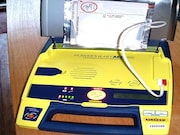Better access to automated external defibrillators could up coverage for out-of-hospital cardiac arrest
MONDAY, Sept. 16, 2019 (HealthDay News) — Optimized placement of automated external defibrillators (AEDs) could increase out-of-hospital cardiac arrest (OHCA) coverage over real AED placements, according to an in silico study published in the Sept. 24 issue of the Journal of the American College of Cardiology.
Christopher L.F. Sun, Ph.D., from the University of Toronto, and colleagues conducted a retrospective in silico (i.e., computer simulation) trial of an AED placement intervention. From 2007 to 2016, all public OHCAs of presumed cardiac cause and real AEDs deployed were identified as a control group. Models were used to optimize an equal number of AEDs to the control group in locations with availabilities based on building hours (intervention 1) or 24/7 access (intervention 2).
The researchers identified 673 public OHCAs and 1,573 registered AEDs during 2007 to 2016. With real AED placements, OHCA coverage was 22.0 percent. With interventions 1 and 2, OHCA coverage increased to 33.4 and 43.1 percent (gains of 52.0 to 95.9 percent). There was an increase in bystander defibrillation from 14.6 percent in the control group to 22.5 and 26.9 percent with interventions 1 and 2, respectively (relative increase, 52.9 to 83.5 percent). An increase was also noted in 30-day survival rates from 31.3 percent (control group) to 34.7 to 35.4 percent, respectively (relative increase, 11.0 to 13.3 percent).
“These results suggest that optimization approaches can serve as the foundation for an AED placement strategy to improve bystander defibrillation and survival,” the authors write.
One author disclosed financial ties to the pharmaceutical industry.
Copyright © 2019 HealthDay. All rights reserved.








